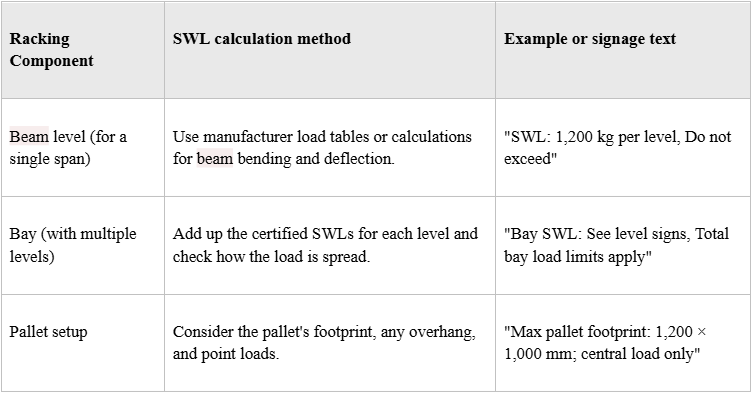
Pallet racking is the backbone of efficient warehousing. AS 4084.1:2023 is the current Australian standard that sets out how steel storage racking must be designed, fabricated, erected, inspected and maintained to protect people and assets. This guide breaks down what AS 4084.1:2023 requires, how it differs from the 2012 edition, and the practical steps warehouses should take to reduce collapse risk, meet legal duties and stay audit-ready. You’ll get clear guidance on inspection timing, who qualifies as a competent person, how to calculate and display Safe Working Loads (SWL), and what regulators such as Safe Work Australia and WorkSafe Victoria expect. The article also maps clause-level changes, supplies comparison tables and actionable checklists to assess your racking. Practical examples, EAV comparisons and Skyteck Online service options are included to help translate the standard into a cost-effective compliance program that balances safety and operability.
What is AS 4084.1:2023 and why it matters for pallet racking safety in Australia
AS 4084.1:2023 is the Australian Standard for steel pallet racking systems. It defines minimum requirements for design, fabrication, erection, testing, operation and maintenance so racking performs predictably under load and across its service life. The standard sets engineering criteria, inspection regimes and responsibilities that reduce the risk of progressive collapse, clarify who must inspect and maintain systems, and provide evidence for WHS audits or incident investigations. Grasping the scope and objectives of AS 4084.1:2023 is the first step toward a defensible storage environment and prepares operators for the inspection and maintenance actions described below.
What are the key objectives and scope of AS 4084.1:2023?
The standard’s primary goal is structural adequacy: it specifies design loads, fabrication tolerances, anchoring and bracing rules, and lifetime inspection and maintenance requirements. AS 4084.1:2023 covers common steel racking types (selective, double-deep, drive-in), and adds guidance for outdoor installations and corrosion protection where relevant. It also defines deliverables from designers and fabricators, such as certified calculations, drawings and material specs, that support safe erection and long-term performance. These engineering controls translate into practical protections at your warehouse: correctly anchored uprights, appropriate bracing, and traceable manufacturing records that reduce unexpected failures.
How does AS 4084.1:2023 improve warehouse safety and compliance?
The 2023 update tightens the definition of a competent person, raises inspection and reporting expectations, and clarifies previously ambiguous topics such as outdoor racking and corrosion mitigation. By setting out inspection content and required documentation, the standard makes it easier for operators to demonstrate due diligence in audits or incident reviews. Practical outcomes include lower collapse risk through better anchoring, clearer collision-protection expectations for forklift activity, and explicit repair protocols for damaged uprights and beams. The clearer allocation of duties also helps warehouse procedures align with regulator expectations from Safe Work Australia and state WorkSafe agencies, enabling more consistent enforcement and corrective actions.
What are the major changes in AS 4084.1:2023 compared with the 2012 version?
AS 4084.1:2023 introduces material updates affecting design, installation and inspection practice. Key changes touch inspection mandates, the competent person definition, outdoor racking and anchoring requirements. The revised standard tightens fabrication and erection tolerances, gives clearer guidance on corrosion protection for outdoor and refrigerated storage, and expands expected documentation from designers and installers. Operators should use the update to audit existing racking against clause-level changes, prioritise repairs and update maintenance schedules to meet the new inspection and reporting expectations. The table below summarises the principal shifts to help prioritise actions.
This table highlights the main differences and practical implications so warehouse managers can map actions to specific clauses.

Which design and installation requirements were updated in AS 4084.1:2023?
Key design and installation updates focus on anchoring, permitted erection tolerances, and clearer documentation expectations from fabricators and installers. The standard requires confirmation that uprights and footplates are anchored to the substrate with specified anchor types and embedment depths appropriate to the loads. Fabrication tolerances, connection fittings and beam engagement depths are now more prescriptive, reducing the on-site ambiguity that previously caused inconsistent assembly. For operators, this means verifying that manufacturer or engineer drawings match as-built conditions and scheduling corrective anchor or bracing works where necessary to meet the standard.
How do the new inspection and maintenance rules differ from previous standards?
The 2023 standard formalises inspection intervals and content. Annual inspections by a competent person must produce a written report and corrective-action list, while routine checks remain the responsibility of site personnel. Compared with 2012, there is clearer direction on post-impact inspections after forklift collisions and on applying timely repairs or load restrictions until fixes are made. Maintenance guidance now emphasises documented repair procedures and retention of inspection records. This increases accountability and requires operators to systematise inspection schedules, reporting templates and follow-up repair workflows.
How often should pallet racking be inspected in Australia and who can perform these inspections?
AS 4084.1:2023 uses a layered inspection model. This includes daily or routine checks by on-site staff, targeted inspections after impacts or severe weather, and a formal annual inspection by a competent person who documents findings and corrective actions. This tiered approach captures early damage while delivering periodic engineering-level assurance. Routine checks identify obvious issues like missing signage, displaced beams or bent uprights, while annual inspections verify dimensions, anchor condition, bracing and load ratings. The mandatory annual formal inspection creates a predictable compliance cadence that can be scheduled and evidenced in regulator audits.
Operators should understand the inspection types, who may perform them and the expected outputs; the table below clarifies responsibilities and intervals.

What qualifications define a “competent person” for pallet racking inspections?
A competent person under AS 4084.1:2023 has demonstrable training, qualifications or experience in racking design, inspection and repair and can reliably assess structural condition and recommend engineering-appropriate actions. Signs of competence include formal training in racking inspection, engineering or technical credentials, experience with racking failure modes, and familiarity with relevant standards and regulator expectations. Practical evidence is typically past inspection reports, references, and the ability to interpret drawings and confirm load ratings. Choosing a competent person ensures inspection findings are actionable and defensible in audits or incident reviews.
What are the mandatory inspection intervals and procedures under AS 4084.1:2023?
The standard mandates routine on-site checks, immediate post-impact inspections, and a formal annual inspection by a competent person that results in a written report and corrective schedule. Routine checks should record visible damage to uprights, beams, anchors, bracing and load signage using a standard checklist. After any significant forklift collision or environmental event, perform a targeted inspection and isolate damaged racking until repaired. The annual inspection should include dimensional checks, anchor verification, bracing integrity and SWL confirmations, with findings prioritised by risk and logged for follow-up.
What are the Safe Working Load requirements and load signage guidelines for pallet racking?
Safe Working Load (SWL) is the maximum load a racking component or level is rated to carry. SWL should come from manufacturer load tables or be calculated and verified by a qualified engineer, taking into account beam span, section properties, pallet footprint and load distribution. Displaying SWL clearly at each bay or level is both an operational necessity and part of compliance evidence. Signage prevents overloading, guides operators and supports incident investigations. Proper signage shows the SWL value, the unit (e.g., kg), the scope (per level or per bay) and any operational notes such as maximum pallet overhang.
The table below outlines component-level calculation methods and sample signage to help standardise practice on site.

How is the Safe Working Load calculated and displayed on racking systems?
SWL is determined from structural calculations or manufacturer load tables that consider beam section modulus, span, connections and pallet load shape. A qualified engineer should verify any ratings not provided by the manufacturer. Once established, SWL must be displayed where operators can see it, typically at each bay or at aisle heads, with clear units and scope like "per level" or "per beam." Signage should be durable, unambiguous and placed at eye level for equipment operators to reduce accidental overloading. Consistent, verified SWL values and signage formats reduce operational confusion and support incident investigations.
Why is proper load signage important for warehouse safety and legal compliance?
Clear load signage reduces the risk of overloading and progressive collapse by giving forklift drivers and supervisors the information they need to load safely and consistently. Legally, SWL signage and retained inspection records are core evidence of due diligence under WHS law and standards compliance. Missing or incorrect signage increases liability and can complicate insurance claims after an incident, while correct signage supports consistent training and safer daily practice. Maintaining and updating signage after repairs or reconfigurations helps embed safe loading behaviour across the workforce.
What are the legal obligations and penalties for non-compliance with pallet racking regulations in Australia?
Operators must meet WHS duties and be able to show that racking systems satisfy the engineering and inspection expectations in AS 4084.1:2023. Failure to do so can trigger enforcement by state regulators, legal liability for injuries and significant operational disruption. Agencies such as WorkSafe Victoria and other state regulators use inspections, incident investigations and audit powers to enforce compliance, issuing improvement or prohibition notices and, when necessary, pursuing prosecution. Non-compliance can also affect insurance coverage and contractual obligations with customers who require documented safety management. Preparing and retaining inspection, repair and maintenance evidence provides a strong defence against regulatory action and reduces operational risk.
Common consequences organisations should avoid include:
- Regulatory notices and fines: You might get improvement notices, prohibition notices, and monetary penalties for breaking the rules.
- Operational disruption: Unsafe systems can be shut down until they're fixed, which can mess up your supply chains and income.
- Liability and insurance impact: Injury claims and insurance disputes are more likely if maintenance and inspections aren't properly recorded.
These outcomes show why proactive compliance, like documented inspections, timely repairs and formal SWL signage, is both a safety necessity and a business continuity measure.
What are the consequences of failing to meet AS 4084.1:2023 standards?
Non-compliance increases the chance of racking failure and worker injury and can lead to enforcement actions such as improvement or prohibition notices, fines or legal proceedings. In practice, non-compliant sites may be stopped from operating until repairs are carried out and documented, and may face financial and reputational damage. Missing inspection records or SWL signage weakens an operator’s position in investigations and raises the likelihood of expensive remediation. Prioritising compliance mitigates these risks and helps preserve operational continuity.
How do WorkSafe Victoria and Safe Work Australia enforce pallet racking regulations?
WorkSafe Victoria and Safe Work Australia enforce standards through inspections, incident investigations, compliance notices and prosecution where warranted, operating under national WHS legislation and state enforcement policies. Regulators check whether organisations have implemented standards-based inspection regimes, retained inspection reports and completed timely repairs for identified risks. Actions range from improvement notices requiring corrective work to criminal prosecution in serious breaches involving reckless conduct or fatalities. Operators benefit from understanding regulator expectations and keeping clear documentation to show active management of racking safety.
How does Skyteck Online support businesses in achieving and maintaining pallet racking compliance?
Skyteck Online provides compliant pallet racking systems, installation, inspection and maintenance services aligned with AS 4084.1:2023 to help businesses turn the standard into practical site procedures. Our services address the needs identified in this guide. These include annual competent-person inspections with written reports, engineering-backed SWL verification and compliant load signage, plus installation and repair work that meets the tightened anchoring and erection tolerances in the 2023 standard. By supplying inspection reports, repair recommendations and compliant signage, Skyteck Online helps reduce collapse risk and build documentary evidence for audits and insurance. We interpret AS 4084.1:2023 in the context of your site and deliver outputs that meet regulatory and operational requirements.
What inspection, installation and maintenance services does Skyteck Online provide?
We deliver formal annual inspections by competent personnel who produce written reports with findings, risk ratings and recommended corrective actions; post-impact inspections and follow-up repairs; compliant installation services addressing anchor and footplate requirements; and supply of SWL signage and repair parts to restore systems to compliant condition. These services align with AS 4084.1:2023 expectations and generate documentation that supports WHS audits and regulator queries. Our integrated approach helps warehouses move from reactive fixes to a planned maintenance regime that reduces safety risk and downtime, with inspection findings rapidly converted into verified repairs.
How can Skyteck Online’s expertise help reduce safety risks and legal liabilities?
Engaging Skyteck Online helps reduce safety risk by ensuring annual competent-person inspections, timely repair of structural components and installations that meet current anchoring and fabrication tolerances, lowering the likelihood of racking collapse. From a legal perspective, inspection reports, repair records and verified SWL signage create a documented compliance trail that supports due diligence defences and regulator engagement. The practical ROI includes fewer incidents, less unplanned downtime and clearer insurance positioning, benefits that protect operators financially and reputationally. Combining internal routine checks with professional annual inspections delivers the most resilient compliance posture.
- Immediate actions: Get an annual inspection done by a competent person and check the SWL signage on your important racking bays.
- Medium-term actions: Focus on upgrading anchors and bracing in high-risk areas you've found, and make sure all repairs are documented.
- Ongoing actions: Start a routine check program, keep all your inspection records, and regularly refresh staff training on load limits.
These steps convert the standard’s requirements into a practical compliance roadmap that balances safety, regulatory risk and operational efficiency.


.svg)






